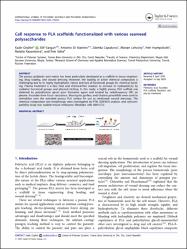Cell response to PLA scaffolds functionalized with various seaweed polysaccharides

View/
Date
2020Author
Ozaltin, KadirVargün, Elif
Di Martino, Antonio
Capakova, Zdenka
Lehocky, Marian
Humpolicek, Petr
Saha, Petr
Metadata
Show full item recordAbstract
The porous polylactic acid matrix has been particularly developed as a scaffold in tissue engineering, drug loading, and wound dressing. However, the loading of active chemical compounds is challenging due to its highly hydrophobic nature and lack of functional groups for chemical bonding. Plasma treatment is a fast, heat and chemical-free solution to increase its hydrophilicity by oxidative functional groups and physical etching. In this study, a highly porous PLA scaffold was obtained by polyethylene glycol pore formation agent and treated by radiofrequency (RF) air plasma. Fucoidan fromFucus vesiculosus,Macrocystis pyrifera, andUndaria pinnatifidawere used to immobilize onto the activated porous PLA surface for use as medicated wound dressings. The chemical composition and morphology were investigated by FTIR, SEM-EDS analysis, and cytocompatibility assay was studied mouse embryonic fibroblast cells (NIH/3T3).

















